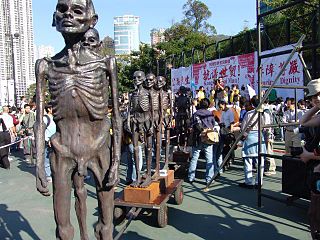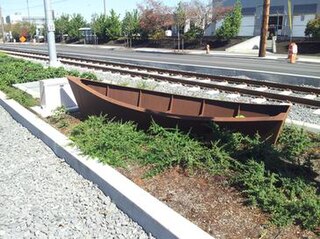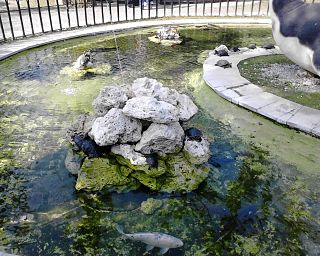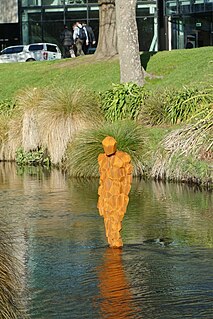 W
WThe Aberlemno Sculptured Stones are a series of five Class I and II Early Medieval standing stones found in and around the village of Aberlemno, Angus, Scotland.
 W
WThe Back Series is a series of four bas-relief sculptures, by Henri Matisse. They are Matisse's largest and most monumental sculptures. The plaster originals are housed in the Musée Matisse in Le Cateau-Cambrésis, France.
 W
WBanality is a series of sculptures by American artist Jeff Koons. The works were unveiled in 1988 and have become controversial for their use of copyrighted images. Several editions of the sculptures have sold at auction for millions of dollars.
 W
WThe Boy with the Leaking Boot is a statue showing a young boy, with a bare right foot, holding up his right boot and looking at it. The statue is about 4 feet (1.2 m) tall, and in many cases forms a fountain, with water emerging from the toe of the boot. There are at least 24, and reportedly "hundreds" of examples. The origins of the statue are obscure. The boy is reported to be a young Italian newspaper seller who drowned, or an American army drummer-boy who carried water in his leaking boot to help fallen comrades, or a young fire-fighter either using his boot in a bucket chain or emptying his boot after an incident, or possibly none of these. The statue has also been called The Boy with the Leaky Boot, Boy Immigrant and Unfortunate Boot.
 W
WThe Capitoline Wolf is a monument in Central Chișinău, Moldova. It is located in front of the National History Museum of Moldova.
 W
WThe Crystal Palace Dinosaurs are a series of sculptures of dinosaurs and other extinct animals, incorrect by modern standards, in the London borough of Bromley's Crystal Palace Park. Commissioned in 1852 to accompany the Crystal Palace after its move from the Great Exhibition in Hyde Park, they were unveiled in 1854 as the first dinosaur sculptures in the world. The models were designed and sculpted by Benjamin Waterhouse Hawkins under the scientific direction of Sir Richard Owen, representing the latest scientific knowledge at the time. The models, also known as Dinosaur Court, were classed as Grade II listed buildings from 1973, extensively restored in 2002, and upgraded to Grade I listed in 2007.
 W
WThe Cubi series is a group of stainless steel sculptures built from cubes, rectangular solids and cylinders with spheroidal or flat endcaps. These pieces are among the last works completed by the sculptor David Smith. The artist died in a car accident on May 23, 1965, soon after the completion of Cubi XXVIII, which may or may not have been the last sculpture he intended to create in this series. The Cubis are among Smith's final experiments in his progression toward a more simplified, abstract form of expression. As an example of Modernism, these are representative of the monumental works in industrial materials that characterized much of the sculpture from this period.
 W
WThe curved space diamond structure is a patented modular building system representative of a diamond crystal enlarged 8 billion times. These playground climbing sculptures were installed in dozens of parks and playgrounds in California, and also throughout the U.S. and Japan in the mid 1970s and early 1980s. Initially installed as playground climbing sculptures, they have also been exhibited as architectural design pieces, referred to as "usable artworks", and sold as art at auction.
 W
WThe Dazu Rock Carvings are a series of Chinese religious sculptures and carvings and UNESCO World Heritage Site located in Dazu District, Chongqing, China. The carvings date back as far as the 7th century AD, depicting and influenced by Buddhist, Confucian and Taoist beliefs. Some are in rock-cut cave shrines, in the usual Chinese Buddhist style, but many others are rock reliefs carved into the open rock faces. Listed as a World Heritage Site in 1999, the Dazu Rock Carvings are made up of 75 protected sites containing some 50,000 statues, with over 100,000 Chinese characters forming inscriptions and epigraphs. The sites are located in Chongqing Municipality within the steep hillsides throughout Dazu District, located about 165 kilometers west of the urban area of Chongqing. The highlights of the rock grotto are found on Mount Baoding and Mount Beishan.
 W
WThe Enchanted Highway is a collection of the world's largest scrap metal sculptures constructed at intervals along a 32-mile (51 km) stretch of two-lane highway in the southwestern part of the U.S. state of North Dakota.
 W
WThe Hiker is a statue created by Theo Alice Ruggles Kitson. It commemorates the American soldiers who fought in the Spanish–American War, the Boxer Rebellion and the Philippine–American War. The first version of it was made for the University of Minnesota in 1906, but at least 50 copies were made, and were erected widely across the United States.
 W
WHomeless Jesus, also known as Jesus the Homeless, is a bronze sculpture by Canadian sculptor Timothy Schmalz depicting Jesus as a homeless person, sleeping on a park bench. The original sculpture was installed at Regis College, University of Toronto, in early 2013. Other casts have since been installed at many places across the world.
 W
WThe Hunger March is the name of a happening and a series of sculptures made by Jens Galschiøt in 2001.
 W
WThe Ideal Scout, also known as The Boy Scout, is the most famous work by Canadian sculptor R. Tait McKenzie (1867–1938). The original statue stood in front of the Cradle of Liberty Council at 22nd and Winter Streets in Philadelphia, Pennsylvania, from 1937 to 2013. Replicas can be found at Boy Scouts of America councils across the United States, as well as at Gilwell Park in London, England, and at Scouts Canada's national office in Ottawa. The Smithsonian American Art Museum's database lists 18 copies.
 W
WSeveral Kamehameha statues honor the monarch who founded the Kingdom of Hawaii.
 W
WMolecule Man is a series of aluminium sculptures, designed by American artist Jonathan Borofsky, installed at various locations around the world, including Germany and the United States. Borofsky made the first Molecule Man sculptures for locations in Los Angeles in 1977 and 1978. They were installed later in 1981 and 1983.
 W
WThe Monifieth Sculptured Stones are a series of five class II and III standing Pictish stones from the early Medieval period found in or around St Regulus' church in Monifieth, Angus, Scotland. Uncovered during the demolition of a pre-Reformation church and its kirkyard wall in the 19th and 20th centuries, the stones are now housed in the collection of the Museum of Scotland.
 W
WPassage is an outdoor 2014 art installation consisting of 38 weathered steel boat sculptures by Bill Will, installed along the MAX Orange Line in the Brooklyn neighborhood of southeast Portland, Oregon, in the United States.
 W
WThe Prehistoric Park is an Italian naturalistic park of more than 100 hectares of wood, situated on the outskirts of the Rivolta d'Adda commune, Cremona province, about 20 kilometers east of Milan. The park is adjacent to the homonym Adda river and contains 30 reconstructions of prehistoric animals, a hundred semi-liberty wild animals, a botanical itinerary with plants signalled, natural environments, picnic reggeds areas, a café, playing parks, a labyrinth, and shows of fossils, etc., all along a shaded course. The access to the park is exclusively pedestrian, but access is allowed to bicycles and dogs with leashes. The park is also recognized by various national and local corporate bodies that testify to the validity of the structure as a guide to the environmental education, not only to children, but of adults as well.
 W
WSphere Within Sphere is a bronze sculpture by Italian sculptor Arnaldo Pomodoro.
 W
WStay are identical cast iron human form sculptures made by Antony Gormley and installed in two locations in the central city of Christchurch, New Zealand. The first sculpture was installed in the Avon River in September 2015. The second in the Northern Quadrangle of the Christchurch Arts Centre was unveiled on 1 October 2016.
 W
WStratum, also known as the "Stratum Project", is a series of 23 sculptures by landscape architect Mikyoung Kim, installed near Portland, Oregon's Sellwood Bridge, in the United States.
 W
WUnconditional Surrender is a series of computer-generated sculptures by Seward Johnson that resemble a 1945 photograph by Alfred Eisenstaedt, V–J day in Times Square, but is said by Johnson to be based on a similar, less well known, photograph by Victor Jorgensen that is in the public domain. The first in the series was installed temporarily in Sarasota, Florida, then was moved to San Diego, California and New York City. Others in the series have been installed in Hamilton, New Jersey; Pearl Harbor, Hawaii; and Normandy, France. Johnson later identified the sculpture at exhibitions as "Embracing Peace" for the double entendre.
 W
WBuddy Bears are painted, life-size fiberglass bear sculptures developed by German businesspeople Klaus and Eva Herlitz, in cooperation with sculptor Roman Strobl. They have become a landmark of Berlin and are considered unofficial ambassadors of Germany. The outstretched arms of the standing Buddy Bear symbolise friendliness and optimism. The first bears were displayed at an artistic event in Berlin in 2001.
 W
WVolubilis ("intertwined") is a series of marble sculptures by French sculptor Alfred Boucher (1850–1934), mentor to Camille Claudel and friend of Auguste Rodin.